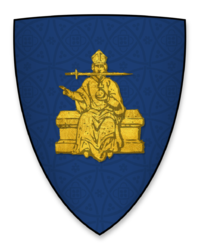List of bishops of Chichester and precursor offices
| Bishop of Chichester | |
|---|---|
| Bishopric | |
| anglican | |

Arms of the Bishop of Chichester: Azure, Our Blessed Lord in judgement seated on His throne His right hand upraised or His left hand holding an open book proper and out of His mouth a two-edged sword point to the sinister gules)
|
|
| Incumbent: Martin Warner |
|
| Province | Canterbury |
| Diocese | Chichester |
| Cathedral |
Chichester Cathedral (since 1075) Selsey Abbey (681–1075) |
| Residence | The Palace, Chichester |
| First incumbent |
Wilfrid (as Bishop of Selsey) Stigand (as Bishop of Chichester) |
| Formation | 681 (founded at Selsey) 1075 (translated to Chichester) |
The Bishop of Chichester is the ordinary of the Church of England Diocese of Chichester in the Province of Canterbury. The diocese covers the counties of East and West Sussex. The see is based in the City of Chichester where the bishop's seat is located at the Cathedral Church of the Holy Trinity. On 3 May 2012 the appointment was announced of Martin Warner, Bishop of Whitby, as the next Bishop of Chichester. His enthronement took place on 25 November 2012 in Chichester Cathedral.
The bishop's residence is The Palace, Chichester. Since 2015, Warner has also fulfilled the diocesan-wide role of alternative episcopal oversight, following the decision by Mark Sowerby, Bishop of Horsham, to recognise the orders of priests and bishops who are women.
The episcopal see at Selsey was founded by Saint Wilfrid, formerly Bishop of the Northumbrians, for the Anglo-Saxon Kingdom of Sussex in the late 7th century. He was granted land by Æthelwealh of Sussex to build a cathedral at Selsey. However, shortly afterwards Cædwalla of Wessex conquered the Kingdom of Sussex, but he confirmed the grant to Wilfrid. The bishop's seat was located at Selsey Abbey. Nine years after the Norman conquest, in 1075, the Council of London enacted that episcopal sees should be removed to cities or larger towns. Accordingly, the see at Selsey was removed to Chichester. Some sources claim that Stigand, the last Bishop of Selsey, continued to use the title Bishop of Selsey until 1082, before adopting the new title Bishop of Chichester, indicating that the transfer took several years to complete.
...
Wikipedia
